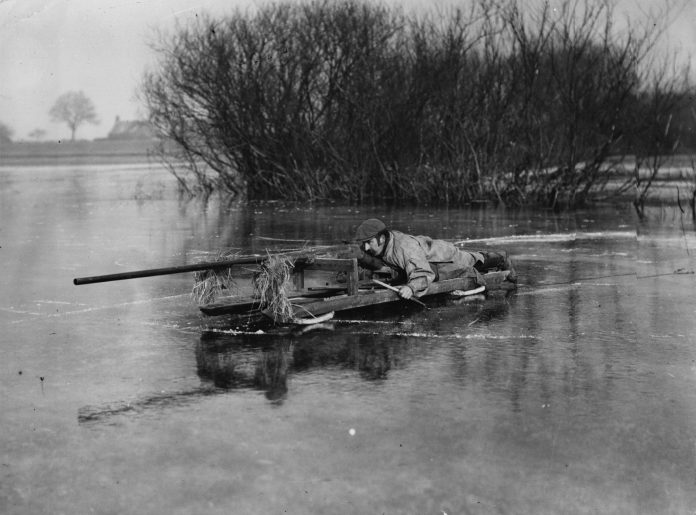We may earn revenue from the products available on this page and participate in affiliate programs. Learn more ›
The largest shotguns ever made—outside of artillery firing grapeshot—punt guns had bores measured in inches. Mounted in the bows of the small gunning punts they were named for, punt guns were sculled or rowed into range of resting flocks of waterfowl and discharged, sometimes killing 50 or even 100 with a single shot.
Primarily used by market hunters in the years when selling wild game was legal, punt guns achieved popularity among sport hunters in the British Isles in the 19th century. Although blasting ducks and geese with a cannon seems as unsporting as hunting can get, in fact, the big bags only occurred when conditions were right. Often gunners returned to shore after a long night of paddling, sculling, and, sometimes pushing punts in bays and marshes without having fired a shot. And, navigating coastal bays and marshes in a small boat with a 200-pound cannon on board was hard, dangerous work.
The Early Days of the Punt Gun
Both hunting and sporting punt guns first appeared in the early 19th century. The first punt guns seem to have been used by market hunters in the British Isles. Those guns were one-of-a-kind models made by local gunsmiths to order. Before long, market hunting with punt guns had spread to America and Europe. With bores typically measuring 1½ to 2 inches, punt guns measured 12 to 14 feet long, weighed 150 to 200 pounds, and fired a pound or more of shot. Too heavy to be carried, they were mounted in the bows of punts (and occasionally on carts), and fixed in the boat so it could absorb the recoil. With gunners lying down to remain unseen, punts were paddled into firing position with short-handled sculls. The gun was aimed by aiming the boat, although some guns could be traversed slightly. Gunners gathered and sold the birds they shot to feed the populations of growing cities in the 19th century.
Punt gunning would have remained a blue-collar trade if not for Colonel Peter Hawker. Invalided out of the army due to wounds received in the Napoleonic wars, and born to a wealthy family, Hawker had the time and money to pursue his love of shooting, including wildfowling on the south coast of England. Through his writings, Hawker popularized punt gunning among the moneyed classes. His own gun, a massive double he bought for the equivalent of nearly $300,000 today, was built by famous gunmaker Durs Egg, and modified by a who’s who of London gunmakers. It featured one flint and one percussion lock. The idea was the percussion barrel would fire immediately, then the slower flintlock would ignite to fire in the flock as it rose off the water and the boat rocked back under recoil, tilting the muzzle upward.

Peak Punt Gunning
As punt gunning became a fad among the well-to-do, wildfowlers ordered guns from some of England’s most prestigious makers. The largest of those guns, the famous “Irish Tom” fired over three pounds of shot, and was once credited with killing 100 birds in a single go. Like smaller shotguns, punt guns made the transition from flint to percussion to breech-loading actions. Most of those latter guns had a screw-in breech and they fired shells nine or more inches long.
Sir Ralph Payne-Galway succeeded Hawker as the leading promoter of the gentlemanly art of punt gunning in England. He hunted and wrote about the sport through the late 19th and first part of the 20th century. His personal gun was also a double, made by the prestigious Holland and Holland of London.
Meanwhile, across the Atlantic, market hunters sculled the eastern seaboard with punt guns, and with their smaller cousins, battery guns, consisting of several 12-gauge or sometimes larger barrels rigged to fire at once. A Chesapeake Bay market hunter named Ray Todd reported that four punt guns charged with a total of seven pounds of shot among them once killed 419 redheads with a single volley. Todd’s group finished the night with 1,000 birds worth $3.50 a brace in the Baltimore market. The four hunters had to make three trips to shore and back and enlist the help of their friends to pick up all the birds.

Market hunters in Europe made sufficient use of the punt gun that both Manufrance and Beretta offered in their catalogs. A gun and elaborate punt sits outside the Beretta museum in Brescia, Italy. Made in the early part of the 20th century, the boat has three sets of oarlocks and unique hand-cranked twin propellors for sneaking close to resting birds.
Read Next: The 50 Best Shotguns of All Time
The End of the Era
Market hunting devastated North American waterfowl populations. In response, Congress banned the sale of game with the Lacey Act of 1900. The Migratory Bird Treaty of 1918 outlawed guns larger than 10-gauge for migratory bird hunting, making punt guns illegal for any type of hunting. Some outlaw hunters kept their big guns hidden, but the truth is, a semiautomatic 12-gauge with an extended magazine had already made the punt gun obsolete.
On the Continent, Beretta, Manufrance, and possibly others offered punt guns until the start of WWII, and did not resume production afterward. Punt gunning does hang on in England and Scotland, practiced by a handful of hardy wildfowlers. The Countryside Act of 1981 limited their guns to bores no larger than 1¾ inches, and those very few punt gunners still ply the coastal waters, hoping for a shot and keeping the tradition of hunting with the biggest guns ever made alive.








